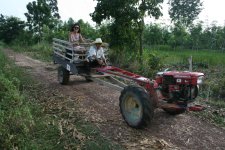jcraftenworth
Silver Member
Well I've been trained from the ag industry and also from bcs promotions that "gear drive and pto" is the most efficient and durable. But, after watching many asians working their diesel machines with large flywheels and belt pulleys on youtube, it seems like they get the job done pretty well. it seems like ptos are less popular there, and all the machines and implements are on belt power systems. Did they just get started on that system a long time ago and now they have so many machines and attachments for the machines that they became the standard? Cheaper and easier to stick with that system than to change over to the "more durable" gear drives and ptos?
What's the upsides and downsides to the belts? Loss of efficiency, need to change belts? how much power is lost? but on the upside, seems like as long as they got a belt handy, then the only thing that they've got to worry about is keeping the main engine running and serviced. Plus, diesel kubotas and yanmars are pretty dang durable. They don't have to do transmission oil maintainence, clutches, powersafe clutches, hydrostatic pumps, damaged/bent ptos, or tranny rebuilds. Even though those things aren't common or constant worry for bcs machines and gear driven tractors, I guess it's kinda nice to mainly just maintain the main engine, keep some spare belts on hand, and not worry about too many repairs or issues beyond that. They must be fairly dependable machines, I can tell from watching videos those guys are farming a lot more than my 1/2 acre and bcs
What's the upsides and downsides to the belts? Loss of efficiency, need to change belts? how much power is lost? but on the upside, seems like as long as they got a belt handy, then the only thing that they've got to worry about is keeping the main engine running and serviced. Plus, diesel kubotas and yanmars are pretty dang durable. They don't have to do transmission oil maintainence, clutches, powersafe clutches, hydrostatic pumps, damaged/bent ptos, or tranny rebuilds. Even though those things aren't common or constant worry for bcs machines and gear driven tractors, I guess it's kinda nice to mainly just maintain the main engine, keep some spare belts on hand, and not worry about too many repairs or issues beyond that. They must be fairly dependable machines, I can tell from watching videos those guys are farming a lot more than my 1/2 acre and bcs
